By Dr. Christopher Kent
Some doctors have asked if they can avoid the scrutiny of insurers by having patients pay cash, and encouraging the patient submit the superbill to their insurance company for reimbursement. A superbill which references ICD and CPT codes may create exposure. The insurer, and the regulatory board, may contend that in issuing the superbill, the doctor is affirming that the diagnosis and treatment rendered are reflected in the codes, and appropriate standards of care are applicable.
The ICD and CPT codes are for conditions. If a doctor issues a superbill which reflects a diagnosis code, he/she is stating that the appropriate standard of care for determining that condition has been met, treatment appropriate for that code has been provided, and adequate records have been maintained.
The problem is that chiropractic is not the diagnosis and treatment of disease. There is no code for a chiropractic adjustment there are only codes for Chiropractic Manipulative Therapy, which is not the same thing. Analysis and adjusting subluxations, particularly if there is no identifiable “condition” apart from subluxation is not generally covered.
As I have often stated, insurance generally does not cover chiropractic care. It will pay chiropractors to diagnose and treat a narrow range of NMS conditions using physical medicine procedures. There are no codes for correcting interference to Innate expression. The superbill is a potential trap. A safer approach is issuing an itemized bill describing the services rendered without using codes. And that may mean no reimbursement.
DCs have to decide, to borrow a concept from Esteb, whether they are chiropractors or DC degree holders practicing a limited branch of physical medicine. They must decide if they fit better in the world of healthy lifestyle strategies, like good food, clean water, exercise, positive thinking, etc. or the allopathic world of drugs, flu shots, and symptom chasing.
The “schizophrenic practice” is a contradiction that is killing the profession. DCs want the insurance bucks to cover the up front costs of exams and frequent visits. Then they want to switch to cash when the frequency of visits becomes more affordable. So they issue superbills with codes to get their patients paid. But often, they don’t do the largely worthless orthopedic exams required to support a reimbursable diagnosis, or adequately document the history and findings required to support the medical diagnosis. They bill for visits until they’re cut off, and then make their “maintenance care” pitch. When the insurer nails them because their circa 1975 travel cards don’t cut it in today’s documentationobsessed world, they whine.
This is killing the profession. DCs must decide if they’re in or out. The contradiction of the schizophrenic practice attempting to simultaneously practice physical medicine and chiropractic may be fatal to a practice. The contradiction of being accountable to a third party, rather than exercising your clinical judgment as to the best interests of the patient, is fatal to proper care. Letting a third party payer decide what is “allowed” rather than reaching a meeting of the minds regarding the patient’s goals and the services actually needed to achieve those goals is fatal to the doctorpatient relationship. Switching back and forth between “medically necessary” insurance based condition treatment and noncovered wellness care, in the same patient, in my opinion, will not be sustainable in the long term. Contradictions lead to destruction. You can’t serve two masters.
If you want to run an insurance based practice, check your brain and professional judgment at the door, focus on compliance with allopathic guidelines and rules, grovel for a pittance, and accept all the strings connected to that style of practice. Think Timex, not Rolex. And be ready to seek a new career when the bottom falls out, and Doctors of Physical Therapy take over that niche.
The alternative is to have a real cash practice. That’s one where there is no expectation of third party reimbursement. The doctor is accountable to the patient for the care rendered, and the patient is accountable to the doctor for payment. There is no third party meddler, whose interests differ radically from the best interests of both the patient and the doctor. That’s freedom. That’s the ethically and morally defensible relationship between doctor and patient.
DISCLAIMER: This column is provided for educational purposes only. The accuracy or timeliness of the information presented is not warranted, and may not be applicable in your jurisdiction. Always obtain legal advice from qualified local counsel. The information presented is not legal advice, and no attorneyclient relationship is established.






























































































































































